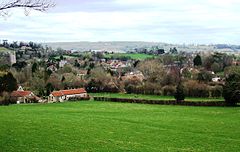Chew Stoke
| Chew Stoke | |
|---|---|
 A view of Chew Stoke |
|
| Chew Stoke shown within Somerset | |
| Population | 991 (2011)(2011 Census) |
| OS grid reference | ST555615 |
| • London | 111 mi (179 km) E |
| Civil parish |
|
| Unitary authority | |
| Ceremonial county | |
| Region | |
| Country | England |
| Sovereign state | United Kingdom |
| Post town | BRISTOL |
| Postcode district | BS40 8 |
| Dialling code | 01275 |
| Police | Avon and Somerset |
| Fire | Avon |
| Ambulance | South Western |
| EU Parliament | South West England |
| UK Parliament | |
Chew Stoke is a small village and civil parish in the Chew Valley, in Somerset, England, about 8 miles (13 km) south of Bristol. It is at the northern edge of the Mendip Hills, a region designated by the United Kingdom as an Area of Outstanding Natural Beauty, and is within the Bristol/Bath green belt. The parish includes the hamlet of Breach Hill, which is approximately 2 miles (3.2 km) southwest of Chew Stoke itself.
Chew Stoke has a long history, as shown by the number and range of its heritage-listed buildings. The village is at the northern end of Chew Valley Lake, which was created in the 1950s, close to a dam, pumping station, sailing club, and fishing lodge. A tributary of the River Chew, which rises in Strode, runs through the village.
The population of 991 is served by one shop, two public houses, a primary school and a bowling club. Together with Chew Magna, it forms the ward of Chew Valley North in the unitary authority of Bath and North East Somerset. Chew Valley School and its associated leisure centre are less than a mile (1.6 km) from Chew Stoke. The village has some areas of light industry but is largely agricultural; many residents commute to nearby cities for employment.
Archaeological excavations carried out between 1953 and 1955 by Philip Rahtz and Ernest Greenfield from the Ministry of Works found evidence of extensive human occupation of the area. Consecutive habitation, spanning thousands of years from the Upper Palaeolithic, Mesolithic, and Neolithic periods (Old, Middle, and New Stone Age), to the Bronze and Iron Ages had left numerous artefacts behind. Discoveries have included stone knives, flint blades, and the head of a mace, along with buildings and graves.
...
Wikipedia

